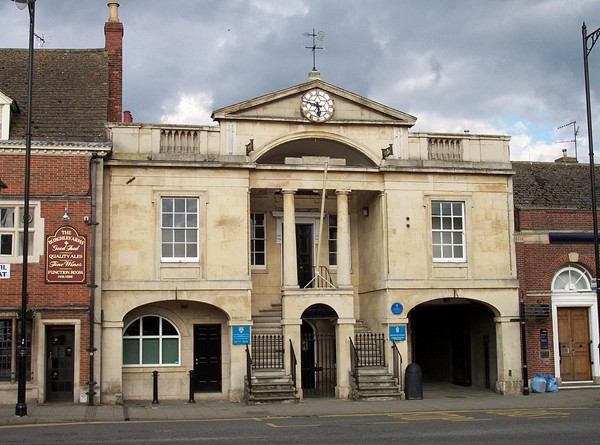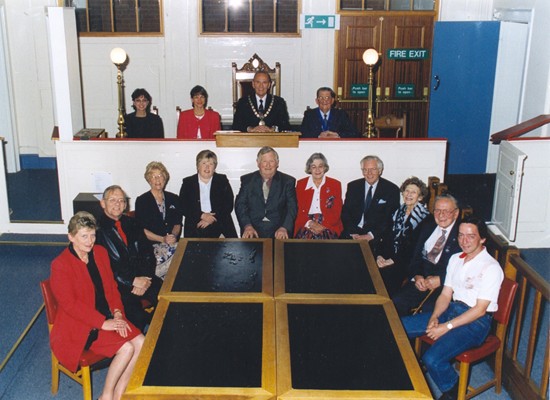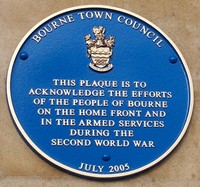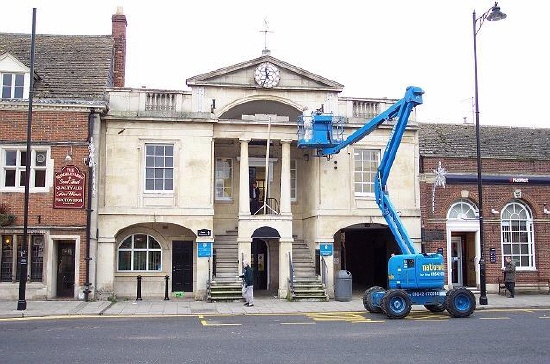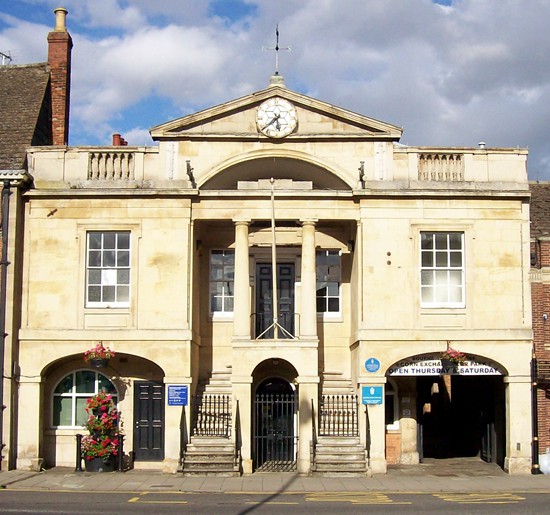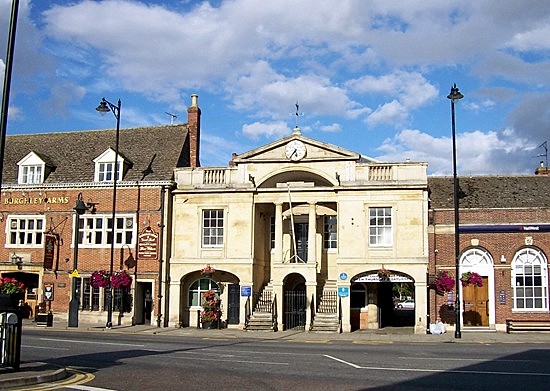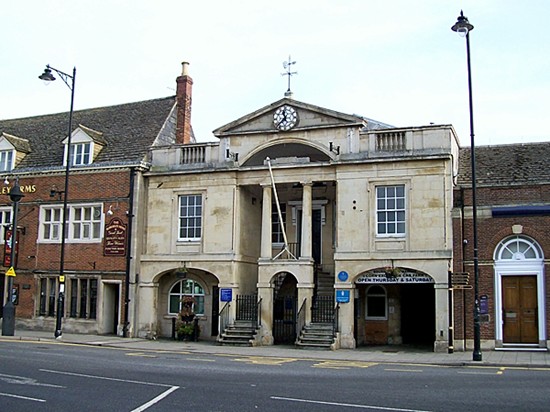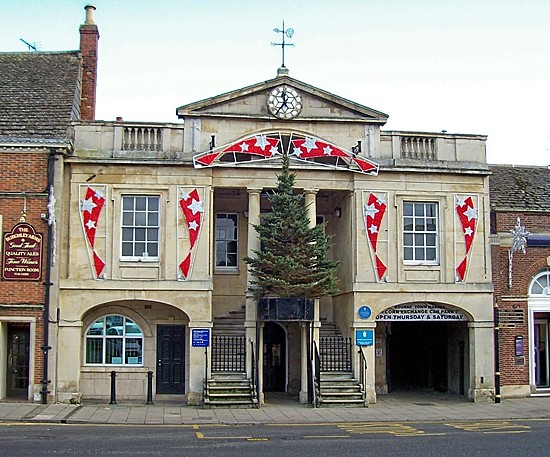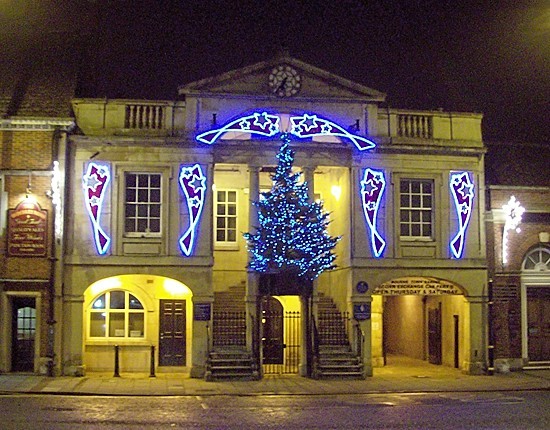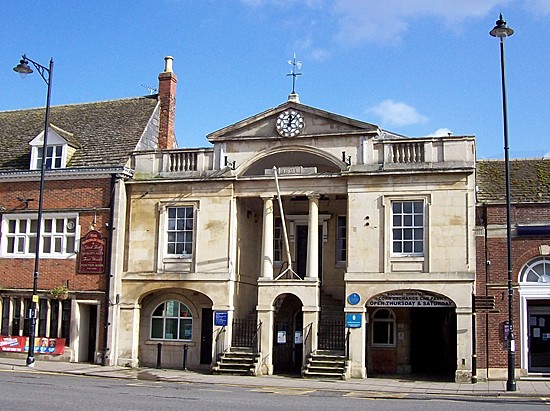|
The Town Hall
There has been a building in the market place at Bourne serving as a town hall for centuries and it was also the centre of the community and particularly for the dispensation of justice through the Petty and Quarter Sessions and the meetings of the various manorial courts that controlled land and property and heard grievances. The earliest reference to a town hall is in 1586 and can be found in an account of the town by the historian William Camden (1551-1623) in Britannia, his survey of the British Isles, which says:
Bourne has four streets, and out streets from these. East to west is 1¼ miles and north to south ¾ of a mile. In the centre of the market place is an ancient town hall, said to have been built by the Wake family. The Cecil arms carved in basso-relief over the centre of the east front and this town hall was probably rebuilt by the Lord Treasurer, Burghleigh.
William Cecil, the Elizabethan statesman and the first Lord Burghley, was born at a house in the market place, now the Burghley Arms, and although Burghley House near Stamford later became his principal residence, it is most likely that he remembered his birthplace by bestowing a new town hall. This building probably stood somewhere near the junction of South Street and West Street and underneath it would have been a shambles and stalls that formed part of the weekly market while the petty and quarter sessions were held in the town hall itself, together with the court of the manor of Bourne of which the Lord was the Marquess of Exeter and both he and his ancestors had been accustomed to receive tolls from the market which also extended to the shops and stalls.
By the early 19th century, the town hall had become dilapidated and a site occupied by a house adjoining the Bull Inn (now the Burghley Arms) on the east side of the market place was chosen for a new building but this too was to have a shambles or set of stalls underneath. The architect Bryan Browning, who later designed Folkingham goal in 1825, was asked to draw up the plans and he decided on an exterior staircase and recessed twin flights of steps within the front of the building that was to be constructed with Doric columns after the fashion of the Roman baths.
The project would be financed with money raised through the county rate, from the sale of salvaged materials from the previous building on the site and from public subscriptions, the appeal being advertised in the Stamford Mercury which also published donations weekly as they came in. Contributions were made not only from residents of Bourne but also from neighbouring parishes such as Market Deeping, Morton and Haconby, which between them eventually raised just under £1,400. A large painted board containing the names of the original subscribers and the amount they contributed is still on display in the main courtroom. An agreement to build the Town Hall was eventually drawn up between the magistrates and the project's organising committee and Bryan Browning's architectural practice, Woolcott and Browning, of 54 Doughty Street, Stamford.
In the event, the total cost was £1,640 plus £811 15s. 1d. for extras that had been decided after the original plans had been approved. These included increasing the height of the building by 2 ft., extending the hall by 6 ft., constructing the front staircase in Portland instead of York stone and increasing the size of the prisoners' room underneath the building from 9 ft. to 14 ft. The tower and the clock, however, were financed separately as a gift to the town by Mrs Eleanor Frances Pochin, widow of George Pochin, who was Lord of the Manor of Bourne Abbots for 37 years from 1761-98, shortly before she died on 16th July 1823 at the age of 76.
Then a procession of local dignitaries was formed which marched to the
site under a canvas awning where Mrs Catherine Digby of the Red Hall and
other ladies of the town and neighbourhood were waiting to welcome the
official party for the stone-laying ceremony. The Rev John Nicholson,
curate at the Abbey Church, said prayers, asking for God's blessing on the
work to be carried out, and the foundation stone was then laid by the
marquess and a second stone was laid by Colonel William Johnson, chairman of the
magistrates and of the organising committee, followed by three "huzzas" or
cheers from the assembled company.
Construction of the building was completed within five months and the Stamford Mercury reported on Friday 19th October 1821: "The new and elegant Town Hall is one of the greatest improvements ever made in a town. By the removal of the old building from the market place, and the erection of this new one in a better situation, Bourne is wonderfully altered; its appearance of closeness and heaviness is removed as if by the hand of a magician, and the town puts on the 'jaunty air' of a lively and prosperous place."
The official opening was held the following week (on Tuesday 23rd October) by Earl Brownlow, Lord Lieutenant of Lincolnshire, accompanied by members of the bench of magistrates and other local and county dignitaries. "It was found to be admirably calculated for a sessions house and for all the uses for which the building was designed", reported the Stamford Mercury.
The new building was soon in frequent use, not only as a court house but for many other varied events both social and official and it appears that permission to hold these was frequently given by individual magistrates without resorting to any other authority. Damage had been caused on some occasions and on 3rd January 1842, the magistrates met under the chairmanship of William Johnson to regularise the position and they passed the following resolution which became the basis for the present licensing system:
It having been represented to this court that frequent applications have heretofore been made to individual magistrates, for the use of the Sessions House at Bourne and the Rooms adjoining, for purposes irrelevant to the object for which the building was erected, and the Hall having occasionally been much injured, it is ordered by this court and her Majesty's Justices of the Peace here present, that all future applications for use of the Hall be made to the Magistrates in Quarter Sessions assembled, and not to individual Magistrates; and that such applications be decided upon by a majority of the Justices then present. - W Forbes, Clerk of the Peace for the said Parts of Kesteven in the County of Lincoln.
By 1845, there were complaints from lawyers attending hearings at the various courts that there was insufficient room for them to sit down and so it was decided to provide more space. Extensive alterations were carried out in the autumn of that year which included the addition of a gallery over the passageway leading to the bench to accommodate the grand jury which sat at the quarter sessions. To accomplish this, a large section of the outer wall was removed and replaced with a new one reinforced with iron supports and brackets. "The effect of this alteration will be to make more room in the court for the legal gentlemen who attend the sessions", reported the Stamford Mercury on Friday 10th October.
The town hall remained in use for almost 200 years and is relatively unchanged except that the shambles has disappeared although the market is still in the vicinity, occupying a purpose built precinct at the rear.
The interior of the Town Hall was altered in 1974-75 and the new layout reduced the size of the main courtroom but it continued as the seat of justice in Bourne and the magistrates' court was held there weekly for summary jurisdiction with a public gallery for anyone who wished to watch the proceedings. The court room was also used for regular meetings of the town council and there was an adjoining library or committee room where the magistrates adjourned to consider their decisions when necessary.
A reception room area with a counter and access from the street was added on the ground floor and used by South Kesteven District Council for the payment of the council tax and other public inquiries. The authority also had offices behind while those of the town council were upstairs at the back, overlooking the new market place. The courtroom was refurbished in the spring of 2004 at a cost of £90,000 and during the autumn, the exterior doors, woodwork and ironwork were also given a fresh coat of paint. Court sittings, however, were phased out in April 2008 and all hearings are now held at Spalding, Grantham, and elsewhere in the county. The Town Hall continued in use by the town council and for district and county council services until March 2013 when all were transferred to a new Community Access Point established at the Corn Exchange, together with the public library from South Street and register office from West Street, thus making the future of the Grade II listed building uncertain. Lincolnshire County Council announced its intention to sell the building but was challenged on the grounds that it did not belong to them but to the people of Bourne. This was subsequently found to be legally correct and by September 2016, a new lease of life had began to unfold for the Town Hall.
REVISED SEPTEMBER 2016
See also
The Town Hall in past times The subscribers The courts of justice
The Town Hall fire of 1933 The Town Hall clock
A new lease of life for the old Town Hall
Go to: Main Index |
